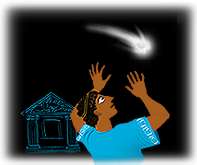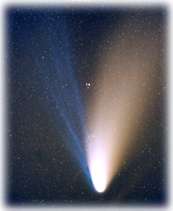| (insert your NIE or newspaper logo here) |
Weekly Online LessonOnline Lesson ArchiveGrade Level: 3-5
|
Stardust Delivers Comet's Clues
 Thanks
to Stardust,
scientists leapt closer to solving some of the mysteries about
the nature of our universe.
Thanks
to Stardust,
scientists leapt closer to solving some of the mysteries about
the nature of our universe.
On Sunday, January 15, 2006, Stardust—a spacecraft that captured dust particles from a comet in 2004—safely landed in Utah.
Scientists were thrilled by the capsule's safe return, because the materials it carries may be some of the oldest in our solar system.
Comets have long been a mystery to us. In ancient times, people watched in awe—and sometimes in fear—as these balls of light sailed across the sky.
A few comets have become predictable visitors, including the one known as Halley's Comet, which has been seen about every 76 years. Its last visit was in 1986.
Today, scientists believe that comets are mostly made of dust, ice, and gases, so they often call them "dirty snowballs."
The Stardust mission is the first to collect comet dust using a material called "aerogel". Scientists hope the aerogel successfully captured particles without damaging them, so that the samples may reveal new clues as to the origins of the solar system.
While it may take a few weeks to get a report on the sample results, you can begin your mission to learn more about comets right away during this week's lesson.
To start, you'll be briefed on the Stardust mission. Then, you'll see how humans have studied comets over the years, and what we know about them today.
The Scoop on Stardust
 Begin
your briefing at the NASA test center: Tails of Wonder.
Begin
your briefing at the NASA test center: Tails of Wonder.
Carefully read the page, and take notes on comet facts.
When you're finished reading, go back to the top of the page and, on the right-hand side, Click to play Tails of Wonder!
After the new window opens, click Start Here to begin. Click Next Question and answer at least eight out of 10 correctly to successfully scoop dust from the comet's tail.
If you have time, take the quiz again to answer new questions!
Why do scientists think studying comets is important? In what ways have comets affected Earth and other planets?
Comets Up-Close & Personal
 Now,
take a trip to the Amazing
Space center to learn more about Comets.
Now,
take a trip to the Amazing
Space center to learn more about Comets.
First, take a step back in time to learn about Comet Facts, Myths & Legends.
Click Enter on the open book, and then click on the red tab, The "hair" out there. Click on the page title to Read on.
Where does the word "comet" come from? What did early scientists believe about comets?
Return to the Contents, then choose the orange tab, Friend or Foe?, and then the yellow tab, What goes around comes around.
What's the earliest record of Halley's Comet? Why is this comet named after Edmund Halley? About how old will you be when the comet reappears?
Under the pink tab, you'll read about the Forecast: Showers likely. What causes these showers? Why are these showers predictable?
Next, get the Crash Course on comets. Where exactly do most scientists believe something hit the Earth about 65 million years ago? What other events did the impact trigger?
On the last page here, see some other Famous Comets. For how long could people see the Hale-Bopp comet during its appearance? Why are these comet cycles so predictable?
Comet Science
 Now
dig deeper into the science of comets. To start, return to the Comet
Lab to open up the Make A Comet recipe book and turn on the Mix machine.
Now
dig deeper into the science of comets. To start, return to the Comet
Lab to open up the Make A Comet recipe book and turn on the Mix machine.
Add a few of the ingredients into the machine, and then click MIX. You'll see the comet you made, and which ingredients make up each part of the comet.
Next, click to See it GO!! Why do the tails get more visible the closer the comet travels near the sun?
Make another one with all ingredients, and then compare it with your first comet. Which ingredients make up the Nucleus/Coma? Which ones make the Dust Tail? How about the Gas/Ion Tail?
Now that you've know how to make comets, go back to the Lab, open the laptop and try your hand at identifying Comet Tails.
How would you explain why the Hale-Bopp comet had a different number of tails at different times during its flight?
Make an Impact
If you have time, explore one more exhibit at Amazing Space: Planet Impact!
As you've learned, comets, meteors, and asteroids, have crashed into planets numerous times over the years. At Planet Impact, find out how a comet's angle and speed of approach to a planet can affect whether the comet hits or misses.
Also, you can compare any comet and see how different planet mass affects a comet.
Lastly, get in some Target Practice and Hit or Miss a planet, based on what you know about comets now.
Newspaper Activities
Look at current issues of The Salt Lake Tribune and find any articles about the Stardust samples. Highlight the names of the particles or elements that scientists have identified. Match each "ingredient" with what part of the comet it is associated with—for example, the nucleus or one type of tail. Over the next few months, add to your list of ingredients as new information is announced. Make a flashcard for each ingredient, by drawing a picture on one side to represent the ingredient and listing facts or descriptions about the ingredient on the opposite side.
© Copyright 2006
Learners Online, Inc.
